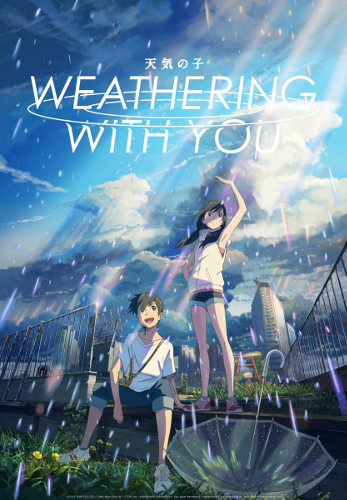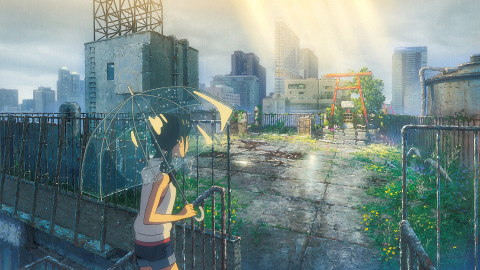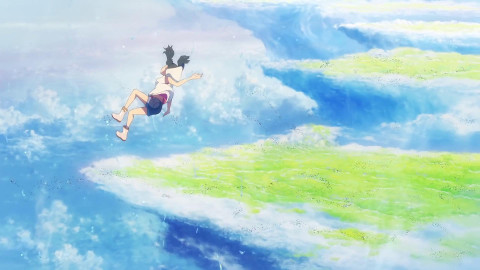Weathering With You (2019)
Directed by: Makoto Shinkai
Written by: Makoto Shinkai
Starring: Kotaro Daigo, Nana Mori, Sei Hiraizumi, Shun Oguri
AKA TENKI NO KO
Japan
IN SELECTED CINEMAS NOW
RUNNING TIME: 116 mins
REVIEWED BY: Dr Lenera, Official HCF Critic
High-school freshman Hodaka Morishima runs away from home and gets himself hired as a live-in writer by Keisuke Suga, the owner of a small publishing company, as well as befriending a girl named Hina who he saves from a dodgy nightclub job by shooting a gun he found. While investigating the urban legend of a weather maiden who can control the weather, he discovers that Hina has powers that enable her to provide short patches of clear weather in an increasingly rainy climate. The two decide to turn this ability into a business, but meanwhile the police are looking for Hodaka because his gun-firing incident was caught on camera….
Still disappointed that I didn’t find the time to review last year’s Mirai, I’m hopefully making up for that by doing a write-up of Makoto Shinkai’s follow-up to his highly popular Your Name which combined teen romance, body swapping and time travel in a pretty infectious mix that was a visual stunner too. Even if you didn’t know it, you could probably tell that Weathering With You was from the same writer/director. The visual style, combining CG and traditional animation to often stunning effect, is unmistakable and has been refined into something possibly even more lovely to look at, while the tale again features a teen love story which is beset by fantastical obstacles, and has a similar structure, especially in the final third which did strike me as being rather predictable. However, this is a more leisurely affair in contrast to Your Name which did tend to rush things at times, and isn’t quite as ‘out there’ or as surprising. There are still, of course, some great, wild ideas, most notably the idea of another land existing on top of clouds, revealed in full in a stunning visual moment when we pull back from some ground covered in lush green grass and see that it’s just the top of a huge grey cloud. But there’s less emphasis on this stuff then you might expect, the film more interested in letting us spend time with its characters, though the romance is slightly less to the fore too. This is also a less happy [despite the tragedies that occurred in it, Your Name maintained a fairly upbeat feel for much of its running time] picture. It’s both gloomy and gritty in many places, set in a constantly waterlogged Tokyo evoked in muted colours with some scenes of considerable intensity and some rather adult ingredients which, though usually just alluded to, helps to make this something that’s somewhat less of a family entertainment that Your Name despite the latter’s breast groping gag – something that’s sorta continued in this film because Hodak keeps getting told off for eyeing up the two female characters including their breasts!
We open to rain, and rain is almost continuous throughout this movie. Maybe Shinkai is especially interested in rain, because after seeing Your Name I checked out two of his other films and 2013’s The Garden Of Words also renders it in considerable detail as well as using it as a plot device? Seeing as I’m a grumpy old sod who seriously dislikes having the sky pour water on him while he’s out trying to get somewhere, and who had to put up with some seriously intense rain for much of last week, I can’t say I share Shinkai’s fascination with this extremely irritating part of our lives, but was still able to appreciate the almost surreal beauty of the many extreme close-ups of raindrops and some huge rain-drop like things that drop occasionally, plus the detail with which the continually rain-beset Tokyo is evoked. As rain pours down onto the city in the opening shot, the camera moves backwards through a window and we see a girl staring out. We then see she’s inside a room of a hospital with a patient on life support in bed, and this immediately sets the tone for much of what follows. We notice sunshine glowing on top of another building as the same girl passes under a Shinto shrine that’s located on top of a high building and finding herself engulfed in water and see-through fish probably made of water, but they will make sense much later, as we now flash back in time and find Hodaka on a ship heading for Tokyo. We never really learn why he’s ran away from home – in fact I was expecting his parents to show up at some point – but this never happens. He almost gets thrown off the ship when a freak rainstorm hits it, but he’s saved by a man named Keisuke Suga, who gives Hodaka his business card in case he ever needs help.
Hodaka thinks he can make it on his own, but can’t even find a place to live. He first meets Hina when he’s in a Macdonald’s and, obviously starving, is given a free burger by her who works there, and by god the rendering actually makes the thing look appealing. Hodaka contacts Keisuke and is hired to work for him, along the way meeting Natsumi, Keisuke’s niece, who he initially mistakes as Suga’s mistress, one of several times when people wrongly assume things about others in this film. Keisuke sends Hodaka and Natsumi out to investigate some urban legends that just might relate to all this terrible weather that Japan is being beset with. Once upon a time, we’re told, there was a Sunshine Girl and a Rain Girl in every village in Japan. It’s very obvious that Hina is going to turn out to be one of these magical folk who have some control over the weather, and some may find the pace too slow as we spend much time hanging out with not just Hodaka and Hina, but also Natsumi, Nagi who is Hina’s younger brother and who could be living with her illicitly, Keisuke, and even Suga’s unnamed daughter who he’s trying to get custody of. But for me it was a nice contrast with the often frantic pacing of Your Name, and it is a rather simpler story that Makoto is telling here – there’s not even a big twist, though there is a minor one. The downbeat tone temporarily subsides when Hina provides her mysterious ability to people who want clear weather for special events, making lots of money for both her and Hodaka. We see their business becoming a great success as it attracts a large number of clients ranging from corporate giants to kindergarten students. However, the police are closing in and Hodaka decides to go on the run with Hina and Nagi. But something strange is beginning to happen to Hina, and her existence might be the actual cause of the abnormal weather which is enhanced during times when she’s very emotional. Her disappearance would return it to normal, but of course Hodaka will have none of this.
You could probably write your version of the rest of the story and it wouldn’t be that different from what Makoto has come up with, but you might be surprised at how powerful some scenes are, especially those involving Hodaka’s gun, there’s a rather realistic human fear and feeling of desperation here. While the weather certainly isn’t providing much fun for most people, it’s decidedly human threats that are the real perils in this film which takes place in a mileau where homelessness, underage prostitution and police brutality take place. Adults are generally people to hide from. There are of course some laughs here and there, but they never detract from the general sad tone. I was actually more emotionally invested in this film’s love story than I was in the one in Your Name, and felt a little of the agony of the two central characters, while of course one cannot help but be constantly reminded of the fact that Japan has suffered so many natural disasters. The film seems to adopt a predominantly philosophical viewpoint to its rain, sort of “that’s the way it is“, even if it doesn’t appear to ask us to dislike Hina’s weather changing antics either. It does suggest that we must accept change even if it may not necessarily seem for the better, but it never hammers us with messaging and I was rather surprised that it wasn’t more full-on seeing how the issue of environmentalism has been a popular anime subject for a very long time. And even when a major action is enacted, we seem to be asked to decide for ourselves whether it was a good or bad act. Things do sadly slip a little in the final act, with no less than three songs playing one after the other as it begins to feel that we’re watching a series of music videos, and extremely predictable events and even staging. One subplot is resolved in an almost throwaway fashion with just two lines of dialogue in a scene that should be really emotional. And the final scene – well, while leaving the end and what follows open to the viewer’s imagination can work, but here you’re just left thinking “what the hell”, as so much is left up in the air.
Shinkai is obviously not interested in going into detail about the stranger things in the film. He’s more interested in lingering on his gorgeous images [which are gorgeous even when dark and gloomy], clearly showing off what he and his animation team have created, but that’s fine. Quite often you’re seeing stuff that’s virtually photorealistic, from the recreations of Tokyo landmarks to seemingly simple things like a door where my gaze was just drawn to how detailed it was. Then you get moments where sunbeams pierce murky skies and suddenly brighten areas up which are divinely beautiful, alongside juxtapositions, like when a cicada – Japan’s emblem of summer – is glimpsed clinging to a pole as snow falls around it. Hand drawn animation doesn’t just alternate with CG animation; the two often exist together in the same shot. Only in a couple of shots is the effect jarring. The music score by the band Radwimps is much better than their effort for Your Name, though I couldn’t tell one song from another and the lyrics as translated tend to mean the same kind of stuff too, slushy puppy-love teeny bopper stuff , though it’s possible that they mean more in Japanese. Talking of language, I again found myself having to watch the English dubbed version because the Japanese language version was only on at a rather awkward time seeing as I had to travel a bit. But the voices, if obviously very American [I don’t know why they never have actual Japanese doing the voices in English], is fine.
Your Name sometimes felt like it was focus-grouped to be as addictive as possible to 16-year olds. Weathering With You only really gets like that towards the end, as if Motoka suddenly felt that he’d got carried away, though the slightly earlier reduction of the character of Keisuke from somebody with a distinct edge to him who uses Hodaka to a routine father figure is also disappointing. One almost senses the studio, Toho, wanting changes, but I’d imagine that Motoka virtually had free reign with this movie after the success of Your Name, a success that Weathering With You has ended up topping. It’s not quite as entertaining as its companion piece [and it really is a companion piece], but it might be the better film out of the two, very successful at balancing romance, grit and whimsy [which by rights ought not to jell too well with each other] – at least until the final section. You’ve got to love a filmmaker today who so clearly wears his heart on his sleeve. And those breathtaking images will linger for a very long time.
Rating: 















Be the first to comment